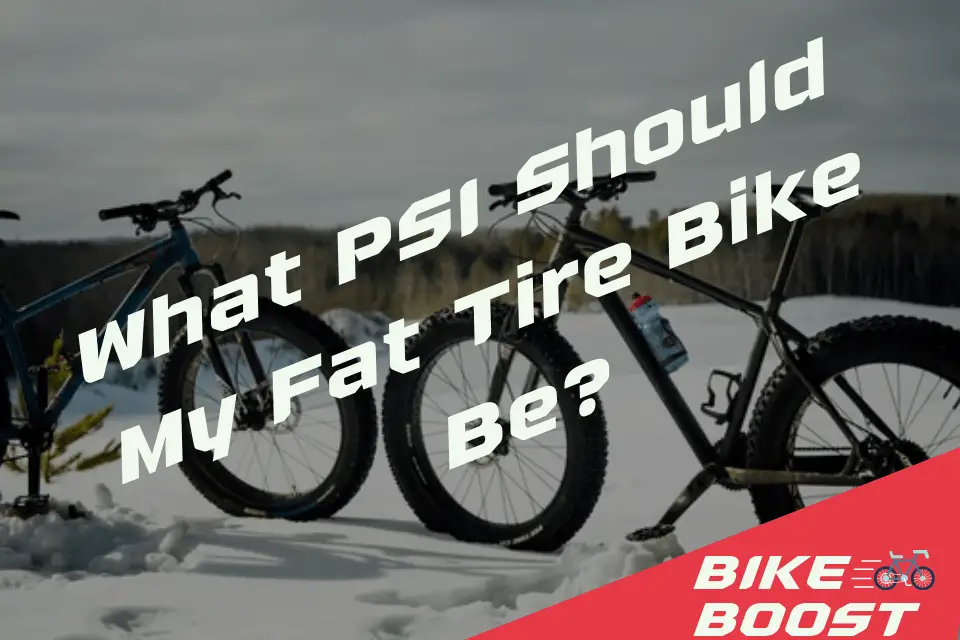As someone who commutes each day, I am always looking for ways to make my ride to work as easy as possible. One of the biggest gains that people often miss when trying to be efficient, is getting their tires at the right pressure, just like with cars. For fat bikes, tire pressure is particularly important, but what PSI should my fat tire bike be? In this guide, I will answer that question.
For those looking at the short answer…
The right PSI for your fat tire bike will depend on the surfaces you will mainly be riding on and the weather conditions, as a quick rule of thumb, a PSI of around 10-12 will go good for riding in harder surfaces and trails during the summer. For winter riding and softer surfaces, a PSI of between 4-6 will provide the right mix of efficiency and balance.
For those who want a more detailed answer, read on.

What PSI Should My Fat Tire Bike Be?
Getting the right PSI for your fat bike tire can be a bit of a minefield, particularly if you are trying to get the most efficient tire pressure. With the tires being wider than other bike tires, there is increased grip on the surface, which increases the rolling resistance when riding. For some surfaces, this is a good thing, with extra grip in ice, snow and sand being very important, however on smoother surfaces like sidewalks and roads, this will slow you down.
Before deciding what the right PSI is that you should set your fat bike tire to, there are a few things to consider:
- Where and when will you do most of your riding? – If you are using your bike on the in the winter on snow, you will need a different tire pressure than if you are riding in the summer on trails.
- How much time do you want to spend adjusting your tire pressures? – If you want to easy life and to only inflate your tires when necessary, you might want to set your tires to an average between two different PSIs. If you’re after peak performance, go for specific PSIs. You will need a good fat bike pump to do this, preferably with a gauge.
The table below shows what PSI you should set your bike’s tires to:
| Riding Surface | Tire Pressure Range in PSI |
|---|---|
| Loose Snow | 1-4 PSI |
| Packed Snow | 2-6 PSI |
| Loose/Dry Sand | 4-6 PSI |
| Packed/Wet Sand | 6-8 PSI |
| Rocky Trails | 6-10 PSI |
| Road/Pavement | 10-15 PSI |
How Do You Pump up A Fat Tire Bike?
The process of how you pump up a fat bike tire is very similar to the process of inflating a bike tire made of gravel or dirt.
- Check the valve type on your bike – Determine the type of valve you have on your bike, which will allow you to determine which adapter you’ll need for your pump.
- Attach your pump to your tire valve – Connect the pump to a tire with the right adaptor, depending upon your requirements for the pump. To make sure that you’re getting the most out of your pump, you need to remove the locknut before you attach the adapter, or else the air won’t get into the tire. For a Presta valve, you should unscrew the nut on the tire when you attach the adapter unless that’s no longer required.
- Inflate the tire/inner tube – Using your pump, inflate the tire. How you do this will depend on the type of pump you have.
- Check the PSI of the tire – It is a wise step, particularly when you are attempting to properly care for a huge fat bike tire. Getting the correct quantity of pressure in the tire will make it a more enjoyable experience.
- Remove the pump from the tire – Remove the pump from the tire/inner tube and add the cap to the valve stem. Make certain to secure the lock nut before working with a Presta valve inner tube.
Related: Lightest Fat Bike Tires
Summary
So there you go, who would have thought it could be so complicated. For me, hitting the middle ground is key. In the warmer months, I would go for around 10-12 PSI, where speed is key. For winter riding where balance is the aim of the game, dropping the PSI down to 4-6 provides great stability.
Andy is an avid cyclist who enjoys nothing more than a ride out in the hills. Competing in track, road, time trial and mountain bike events in the past, he prefers slower rides out with his family these days.
